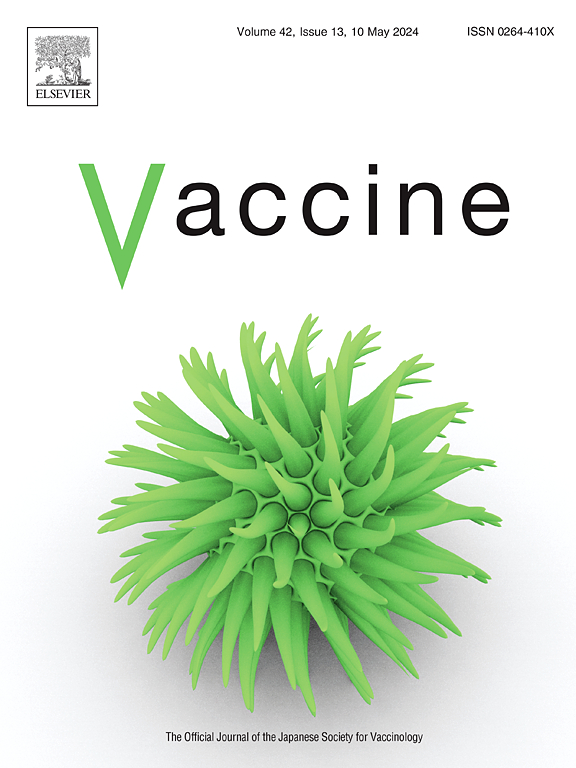Immunogenicity and safety of monovalent and bivalent SARS-CoV-2 variant adapted RBD-based protein booster vaccines in adults previously immunized with different vaccine platforms: A phase II/III, randomized clinical trial
IF 4.5
3区 医学
Q2 IMMUNOLOGY
引用次数: 0
Abstract
A randomized, placebo-controlled, crossover, double-blind, phase II/III study was conducted to evaluate the immunogenicity, safety, and tolerability of a recombinant booster vaccine (ARVAC) containing the SARS-CoV-2 spike protein receptor binding domain in three versions: ARVACGamma, ARVACOmicron, and ARVACBivalent in adults with ≤3 previous SARS-CoV-2 booster doses. Primary endpoint was seroconversion rate of neutralizing antibodies compared to placebo and to a > 75 % seroconversion rate to vaccine antigen homologous variants. All vaccine versions significantly increased seroconversion rates to SARS-CoV-2 variants compared to placebo. In participants aged 18–60 years, all versions met the primary endpoint; in those over 60 years old, ARVACOmicron and ARVACBivalent met this endpoint. No vaccine-related serious adverse events were recorded, and most adverse events were mild. Plasma levels of anti-spike-specific IgG and anti-S1-specific IgA in saliva increased in participants receiving any vaccine. The increase in plasma neutralizing antibodies induced by the vaccine was independent of the number of previous booster doses (0, 1 or 2), the primary vaccine platform (adenovirus, single-dose adenovirus, mRNA, inactivated virus, heterologous vaccination, and virus-like particle [VLP]) and the history of previous COVID-19. The neutralizing Ab response induced by the vaccine in healthy participants was similar to that triggered in participants with underlying medical conditions associated with an increased risk of severe COVID-19. ARVACBivalent induced high seroconversion rates (>90 %) against multiple variants and was superior to other ARVAC-versions. It increased neutralizing antibodies against SARS-CoV-2 variants (Ancestral, Gamma, Omicron, XBB and JN.1) and SARS-CoV-1. (NCT05752201).
单价和二价SARS-CoV-2变体适应rbd蛋白增强疫苗在不同疫苗平台免疫过的成人中的免疫原性和安全性:一项II/III期随机临床试验
一项随机、安慰剂对照、交叉、双盲、II/III期研究评估了含有SARS-CoV-2刺突蛋白受体结合域的重组强化疫苗(ARVAC)的免疫原性、安全性和耐受性,该疫苗分三种版本:ARVACGamma、ARVACOmicron和ARVACBivalent,适用于既往接种过≤3次SARS-CoV-2强化疫苗的成人。主要终点是与安慰剂和a / gt相比,中和抗体的血清转换率;75%血清转换率为疫苗抗原同源变体。与安慰剂相比,所有疫苗版本都显著提高了SARS-CoV-2变体的血清转换率。在18-60岁的参与者中,所有版本都达到了主要终点;在60岁以上的患者中,ARVACOmicron和ARVACBivalent达到了这一终点。没有记录到与疫苗相关的严重不良事件,大多数不良事件是轻微的。在接受任何疫苗的参与者中,唾液中抗尖刺特异性IgG和抗s1特异性IgA的血浆水平都增加了。疫苗诱导血浆中和抗体升高与既往加强剂量(0、1或2次)、一次疫苗平台(腺病毒、单剂腺病毒、mRNA、灭活病毒、异源疫苗和病毒样颗粒[VLP])和既往COVID-19病史无关。疫苗在健康参与者中诱导的中和性Ab反应与在患有与严重COVID-19风险增加相关的潜在医疗条件的参与者中引发的反应相似。arvac2价对多种变体诱导了高血清转换率(90%),优于其他arvac2价。它增加了针对SARS-CoV-2变体(祖代、伽玛、Omicron、XBB和JN.1)和SARS-CoV-1的中和抗体。(NCT05752201)。
本文章由计算机程序翻译,如有差异,请以英文原文为准。
求助全文
约1分钟内获得全文
求助全文
来源期刊

Vaccine
医学-免疫学
CiteScore
8.70
自引率
5.50%
发文量
992
审稿时长
131 days
期刊介绍:
Vaccine is unique in publishing the highest quality science across all disciplines relevant to the field of vaccinology - all original article submissions across basic and clinical research, vaccine manufacturing, history, public policy, behavioral science and ethics, social sciences, safety, and many other related areas are welcomed. The submission categories as given in the Guide for Authors indicate where we receive the most papers. Papers outside these major areas are also welcome and authors are encouraged to contact us with specific questions.
 求助内容:
求助内容: 应助结果提醒方式:
应助结果提醒方式:


